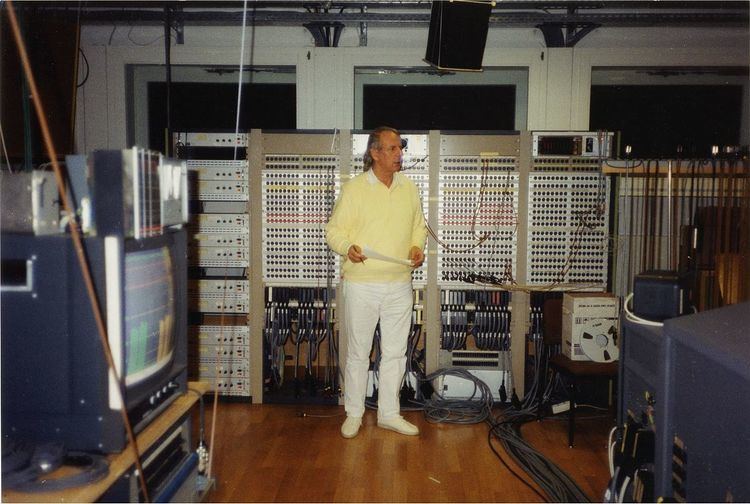Oktophonie (Octophony) is a 1991 octophonic electronic-music composition by Karlheinz Stockhausen. A component layer of act 2 of the opera Dienstag aus Licht, it may also be performed as an independent composition. It has a duration of 69 minutes.
Oktophonie forms a layer of the music in act 2, Invasion—Explosion mit Abschied (Invasion—Explosion with Farewell). The very forceful nature of the electronic music required a technical solution in order that the instrumentalists, who perform at the same time, can always be heard. Stockhausen solved this problem by providing each player with a microphone and a transmitter for amplification, which allows them to move freely throughout the auditiorium. This became a central part of Stockhausen’s performance practice in subsequent parts of the Licht cycle (Toop 2008).
Materials and technique
Oktophonie was realised in the Studio for Electronic Music of the Westdeutscher Rundfunk, Cologne, in two phases of work: from 23 August to 30 November 1990, and from 5 to 30 August 1991. Studio collaborators were recording engineers Volker Müller and Daniel Velasco-Schwarzenberger, and recording technician Gertrud Melcher (Stockhausen 1994, O IX, O XIX; Stockhausen 1998, 340). Production was made using a single 24-track tape recorder. A 64-track recorder would have been preferable, or alternatively three synchronisable 24-track recorders, but the WDR studio had only the one machine. Spatialisation was facilitated by the use of a QUEG (Quadrophonic Effect Generator), a device manufactured by EMS in the early 1970s. It was developed by Stockhausen in collaboration with Peter Zinovieff, owner of the firm at that time. Despite having only four outputs, the QUEG could still be used to produce an octophonic output, by manually switching to four outputs, not only between the square on the floor and the one on the ceiling, but between all six squares forming the sides of the cube (Stockhausen 2000, 68–70). A number of synthesizers and modules were used in the production of the sound layers (Stockhausen 1994, O IX, O XIX):
two Yamaha DX7II-FD synthesizerstwo Casio FZ-1 samplersa Roland D-50 synthesizeran Oberheim Matrix-1000 synthesizer module (without keyboard)an Art Proverb effects unita Roland SDE 2000 reverberation unitan SVC 350 vocoderan Atari 1040 St computerC-Lab Unitor Hardware and Notator Softwarea Yamaha MR 12/4/2 mixing consoleIn addition, an EMS Synthi 100 was used for control of the spatialization in some layers during the concluding portion (Stockhausen 1994, O XV–XVI, O XXV–XXVI).
The music of Oktophonie is developed, like everything in Licht, from the basic superformula, and consists of eight musical layers, each provided with different spatial distributions and sound movement patterns (Misch 1998, 152). For technical reasons of playback the music had to be produced in two segments, with the second tape beginning at 36'23" and a "bridge" tape used only for performances of the second act of Dienstag (Stockhausen 1994, O IX, O XIX; Stockhausen 1998, 342).
1991: World premiere, 29 September, Frankfurt, in the context of the concert premiere of Dienstag aus Licht, given as the conclusion of the Frankfurt Feste '91 (Stockhausen 1993, 163).1993: in the context of the staged world premiere of Dienstag, 28 May, Leipzig Opera (Toop 2008).1994: World premiere of the electronic music alone, 12 June, at the restaurant of the Cologne-Deutz fairgrounds, organised by the Westdeutscher Rundfunk as part of the Kölner Trienniale (Stockhausen 1994, O IX, O XIX; Stockhausen 1998, 342; Stockhausen-Stiftung für Musik 2010, 5).1998: South American premiere, São Paulo, Brazil, at the The International Festival of Electroacoustic Music of São Paulo (BIMESP), held 8–17 October (Anon. 1999; Brümmer et al. 2001, 11).2002: Neue Nationalgalerie at the Kulturforum, Berlin (Trinkl 2007).2002: Stockhausen Courses, Kürten (Moritz 2005).2004: Sonorities Festival, Queen's University Belfast, Sonic Arts Research Centre, Belfast, Northern Ireland, Sunday 25 April (Dervan 2004).2005: Triptych Festival, Queen's Hall, Edinburgh, Saturday 30 April (Walton 2005).2005: West Coast Festival of Numusic 2005, Tou Old Brewery, Stavanger, Norway, Friday 26 August (Solberg 2005; Stockhausen-Stiftung für Musik 2005).2005: Frieze Festival, Old Billingsgate Market, London, 25 October (Anon. 2006; Ashley 2005; Higgins 2005; Sweeting 2005).2007: Stockhausen Courses, Kürten, 15 July (Stockhausen 2007, 23–24, 41–42).2008: Fromm Players at Harvard: 60 Years of Electronic Music, 8 March (Anon. 2008, 11).2008: Stockhausen Courses, Kürten, 7 July (Stockhausen-Stiftung für Musik 2008, 20–22, 62–64).2009: Durham University Musicon series, Music and Electronics, 19 March (Anon. 2009).2009: version with soloists (Signale zur Invasion with Ben Marks, trombone; Pietà with Tristram Williams, flugelhorn, and Jessica Aszodi, soprano; Synthi-Fou with Michael Fowler, electronic keyboards):Turbine Hall, Brisbane Powerhouse, Brisbane, Australia, 25 April (Anon. 2011).Sydney Conservatorium of Music, as part of Smart Light Sydney Festival (a component of Vivid Sydney), Sydney Australia, Saturday, 6 June (Anon. 2011; Fortescue 2009; McCallum 2009).2009: Stockhausen Courses, Kürten, 14 July (Layton 2009).2010: Paris, 26 March, two performances, "avec le soutien technique de Diversity", 4:00pm and 9:00pm, Atelier 4, 104 rue d'Aubervilliers (Ning 2010).2011: Version with soloists (Signale zur Invasion with Andrew Digby, trombone; Pietà with Marco Blaauw, flugelhorn, and Agata Zubel, soprano; Synthi-Fou with Antonio Pérez-Abellán, electronic keyboards), sound projection: Kathinka Pasveer. Stockhausen Courses, Sülztalhalle, Kürten, 9 August (Schwarz 2011).2013: Park Avenue Armory, 9 performances, sound projection: Kathinka Pasveer; design: Rirkrit Tiravanija (Anon. 2013; Mejias 2013; Tharoor 2013; Tommasini 2013).Stockhausen: Oktophonie. Stockhausen Complete Edition CD 41. Kürten: Stockhausen-Verlag, 1994.Stockhausen: Dienstag aus Licht. Annette Meriweather (soprano); Julian Pike (tenor); Nicholas Isherwood (bass); Markus Stockhausen (trumpet and flugelhorn); Michael Svoboda (trombone); Massimiliano Viel, Simon Stockhausen (synthesizers); Andreas Boettger, Renee Jonker (percussion); WDR Choir, Karlheinz Stockhausen (cond.). Stockhausen Complete Edition CD 40A–B. Kürten: Stockhausen-Verlag, 1996.Stockhausen: Solo-Synthi-Fou; Synthi-Fou; Dienstags-Abschied; Klangfarben für Synthi-Fou. Simon Stockhausen (synthesizers); WDR Choir, Karlheinz Stockhausen (cond.). Stockhausen Complete Edition CD 42 A–B. Kürten: Stockhausen-Verlag, 1994.Stockhausen: Michaels-Ruf; Bassettsu; Synthi-Fou; Quitt; Komet; Trompetent. Stockhausen Complete Edition CD 82. Kürten: Stockhausen-Verlag, 2007.
